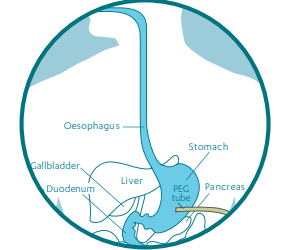 Peg
Peg
Percutaneous Endoscopic Gastrostomy Tube Insertion
What is a PEG?
A Percutaneous Endoscopic Gastrostomy (PEG) is the procedure where
a tube is inserted through the skin of your abdominal wall into your
stomach, to enable you to have liquid food.
Why are you having this procedure?
A PEG is generally recommended for people who experience difficulties
with swallowing. Because of your difficulties with swallowing, your doctor
has asked us to place a percutaneous gastrostomy tube through the skin
of your abdominal wall into your stomach. You will be able to have liquid food
through this tube.
|
During your procedure you will be given sedation. It is important that you arrange for someone to drive you home following your procedure. You are not permitted, by law, to drive yourself. For safety reasons, if you are travelling on public transport, or in a taxi, please arrange for a support person to travel with you.
|